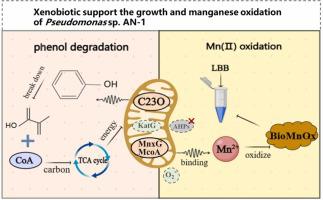当前位置:
X-MOL 学术
›
J. Hazard. Mater.
›
论文详情
Our official English website, www.x-mol.net, welcomes your feedback! (Note: you will need to create a separate account there.)
Can xenobiotics support the growth of Mn(II)-oxidizing bacteria (MnOB)? A case of phenol-utilizing bacteria Pseudomonas sp. AN-1
Journal of Hazardous Materials ( IF 13.6 ) Pub Date : 2024-03-20 , DOI: 10.1016/j.jhazmat.2024.134095 Aonan Qiao , Haixia Pan , Jiaxi Zang , Yiwen Zhang , Xianliang Yi , Yang Liu , Jingjing Zhan , Xiaojing Yang , Xu Zhao , Ang Li , Hao Zhou
Journal of Hazardous Materials ( IF 13.6 ) Pub Date : 2024-03-20 , DOI: 10.1016/j.jhazmat.2024.134095 Aonan Qiao , Haixia Pan , Jiaxi Zang , Yiwen Zhang , Xianliang Yi , Yang Liu , Jingjing Zhan , Xiaojing Yang , Xu Zhao , Ang Li , Hao Zhou

|
Biogenic manganese oxides (BioMnO) produced by Mn(II)-oxidizing bacteria (MnOB) have garnered considerable attention for their exceptional adsorption and oxidation capabilities. However, previous studies have predominantly focused on the role of BioMnOx, neglecting substantial investigation into MnOB themselves. Meanwhile, whether the xenobiotics could support the growth of MnOB as the sole carbon source remains uncertain. In this study, we isolated a strain termed sp. AN-1, capable of utilizing phenol as the sole carbon source. The degradation of phenol took precedence over the accumulation of BioMnOx. In the presence of 100 mg L phenol and 100 µM Mn(II), phenol was entirely degraded within 20 h, while Mn(II) was completely oxidized within 30 h. However, at the higher phenol concentration (500 mg L), phenol degradation reduced to 32% and Mn(II) oxidation did not appear to occur. TOC determination confirmed the ability of strain AN-1 to mineralize phenol. Based on the genomic and proteomics studies, the Mn(II) oxidation and phenol mineralization mechanism of strain AN-1 was further confirmed. Proteome analysis revealed down-regulation of proteins associated with Mn(II) oxidation, including MnxG and McoA, with increasing phenol concentration. Notably, this study observed for the first time that the expression of Mn(II) oxidation proteins is modulated by the concentration of carbon sources. This work provides new insight into the interaction between xenobiotics and MnOB, thus revealing the complexity of biogeochemical cycles of Mn and C.
中文翻译:

异生素能否支持锰 (II) 氧化细菌 (MnOB) 的生长?苯酚利用细菌假单胞菌属一例。 AN-1
由 Mn(II) 氧化细菌 (MnOB) 产生的生物锰氧化物 (BioMnO) 因其卓越的吸附和氧化能力而受到广泛关注。然而,之前的研究主要集中在 BioMnOx 的作用上,忽视了对 MnOB 本身的实质性研究。与此同时,外源物质是否可以作为唯一碳源支持MnOB的生长仍不确定。在这项研究中,我们分离出一种名为 sp. 的菌株。 AN-1,能够利用苯酚作为唯一碳源。苯酚的降解优先于 BioMnOx 的积累。在100 mg·L-1苯酚和100 µM Mn(II)存在下,苯酚在20 h内完全降解,而Mn(II)在30 h内完全氧化。然而,在较高的苯酚浓度(500 mg·L)下,苯酚降解率降低至 32%,并且 Mn(II) 氧化似乎没有发生。 TOC测定证实了菌株AN-1矿化苯酚的能力。基于基因组和蛋白质组学研究,进一步证实了菌株AN-1的Mn(II)氧化和苯酚矿化机制。蛋白质组分析显示,随着苯酚浓度的增加,与 Mn(II) 氧化相关的蛋白质(包括 MnxG 和 McoA)下调。值得注意的是,这项研究首次观察到 Mn(II) 氧化蛋白的表达受碳源浓度的调节。这项工作为外源物与 MnOB 之间的相互作用提供了新的见解,从而揭示了 Mn 和 C 生物地球化学循环的复杂性。
更新日期:2024-03-20
中文翻译:

异生素能否支持锰 (II) 氧化细菌 (MnOB) 的生长?苯酚利用细菌假单胞菌属一例。 AN-1
由 Mn(II) 氧化细菌 (MnOB) 产生的生物锰氧化物 (BioMnO) 因其卓越的吸附和氧化能力而受到广泛关注。然而,之前的研究主要集中在 BioMnOx 的作用上,忽视了对 MnOB 本身的实质性研究。与此同时,外源物质是否可以作为唯一碳源支持MnOB的生长仍不确定。在这项研究中,我们分离出一种名为 sp. 的菌株。 AN-1,能够利用苯酚作为唯一碳源。苯酚的降解优先于 BioMnOx 的积累。在100 mg·L-1苯酚和100 µM Mn(II)存在下,苯酚在20 h内完全降解,而Mn(II)在30 h内完全氧化。然而,在较高的苯酚浓度(500 mg·L)下,苯酚降解率降低至 32%,并且 Mn(II) 氧化似乎没有发生。 TOC测定证实了菌株AN-1矿化苯酚的能力。基于基因组和蛋白质组学研究,进一步证实了菌株AN-1的Mn(II)氧化和苯酚矿化机制。蛋白质组分析显示,随着苯酚浓度的增加,与 Mn(II) 氧化相关的蛋白质(包括 MnxG 和 McoA)下调。值得注意的是,这项研究首次观察到 Mn(II) 氧化蛋白的表达受碳源浓度的调节。这项工作为外源物与 MnOB 之间的相互作用提供了新的见解,从而揭示了 Mn 和 C 生物地球化学循环的复杂性。



























 京公网安备 11010802027423号
京公网安备 11010802027423号